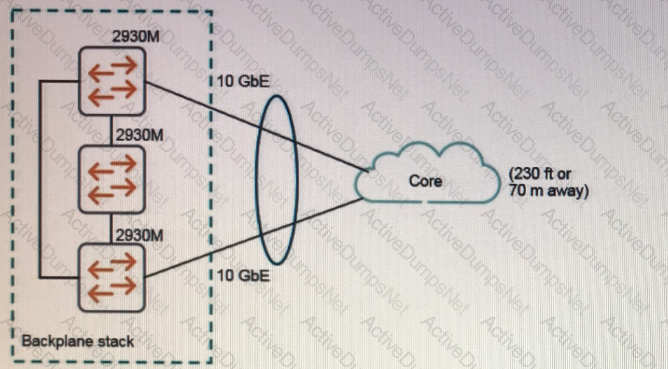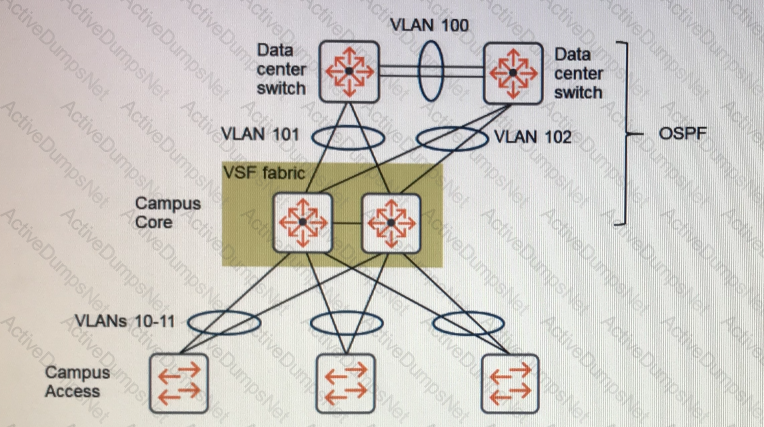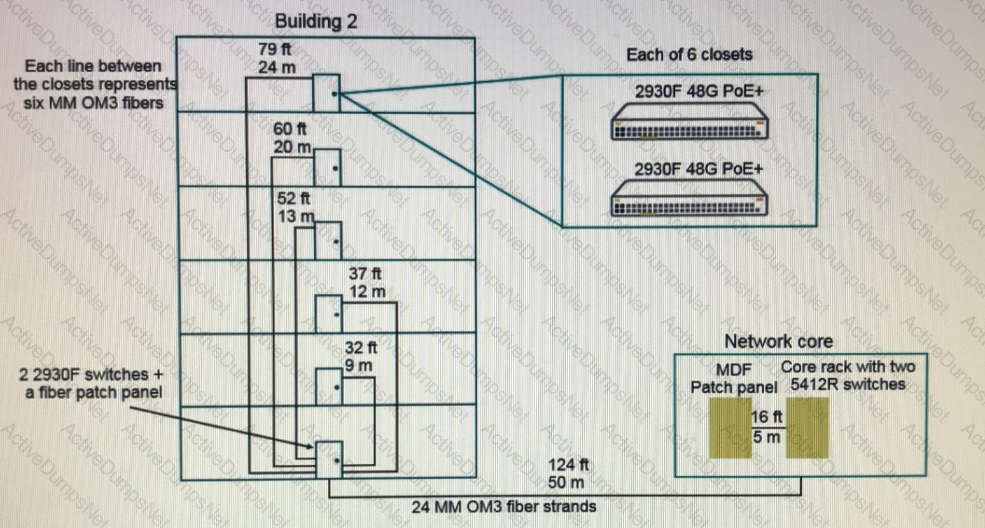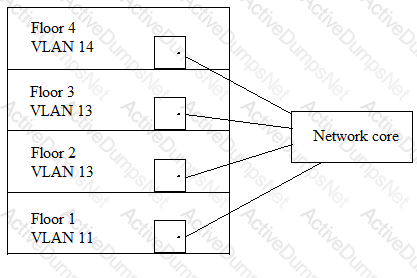HP HPE6-A47 Designing Aruba Solutions Exam Practice Test
Designing Aruba Solutions Questions and Answers
An architect proposes an Aruba solution with a hardware Mobility Master (MM) to a customer. The customer has a disaster recovery site which is connected to the main site at Layer 3. The customer requires the MM to remain available in case of a total site failure.
Which plan meets the customer requirements?
An architect needs to plan a very high density (VHD) wireless network at a large events venue, at which thousands of attendees are expected. The architect plans to deploy a cluster of Mobility Controllers (MCs) to control the APs. It is important to support seamless roaming for wireless devise across the venue.
What should the architect ensure for the network services?
A customer currently has an Instant AP deployment. Which customer requirement would indicate that the customer needs to add a controller to the deployment?
An architect needs to plan 802.11ac wireless deployment for an office environment with a mix of closed offices and cubicles. The coverage area is approximately 4,645 square meters (approximately 50,000 square feet) and has 350 users. The employees use the wireless network for typical office applications, such as email, Web, printing, and accessing shared files and datacenter services.
The architect plans to do a predictive site survey and use VisualRF to plan the coverage. What is a general estimate for the AP count that the architect should have in mind?
An architect needs to plan an 802.11ac wireless upgrade for a university building. What is one reason that it is important for the architect to identify auditoriums?
Refer to the exhibit.
Exhibit 1.

Exhibit 2.

Exhibit 1 shows the logical plan, and Exhibit 2 shows the BOM that the administrator has made in Iris. What is missing from the IRIS BOM?
Read this scenario thoroughly, and then answer each question that displays on the right side of the screen.
An architect proposes these products for a customer who wants a wireless and wired upgrade:
- Aruba 2930M switches at the access layer
- Aruba 5406R switches at the core
- Aruba AP-325s
- Aruba 7205 Mobility Controllers (MCs), deployed in a cluster
- Aruba Mobility Master (MM)
- Aruba ClearPass Cx000V
- Aruba AirWare
The architect also needs to propose a security plan for the solution. The customer has 900 employees and up to 30 guests a day. The customer wants to protect the internal perimeter of the network with authentication and simple access controls. The customer is most concerned about wireless security, but also wants to ensure that only trusted users connect on the wire. However, the customer also wants all wired traffic to be forwarded locally on access layer switches. The customer already has a third-party firewall that protects the data center.
The customer wants to use certificates to authenticate user devices, but is concerned about the complexity of deploying the solution. The architect should recommend a way to simplify. For the most part users connect company-issued laptops to the network. However, users can bring their own devices and connect them to the network. The customer does not know how many devices each user will connect, but expects about two or three per-user. DHCP logs indicate that the network supports a maximum of 2800 devices.
Refer to the provided scenario.
Which solution should the architect recommend on the 2930M switches to authenticate and control wired employee devices?
An architect plans 12 APs for an auditorium that is 325 square meters (3, 498 square feet). Each AP has one 2.4 GHz radio and one 5 GHz radio. Both types of radios use 20 MHz channels.
Assume that DFS channels can be used in this design. How many 5 GHz collision domains does this design provide?
A customer requires a wireless upgrade. The architect proposes:
- Aruba AP-325s
- Mobility Controller (MC) 7210s
- Virtual Mobility Masters (MMs)
- ClearPass
- AirWave
The customer is interested in wired authentication, as well as wireless authentication, but does not have the budget to upgrade the wired network. The wired network does not currently support 802.1X or RADIUS.
Which feature of the Aruba solution should the architect explain to justify the proposed solution?
An architect proposes four 7210 Mobility Controllers (MCs) to support about 1,500 client APs. The customer environment will have a maximum of about 20,000 wireless clients. The customer wants hardware MMs with an active and standby deployment. What is the minimum solution that meets the customer requirements?
An architect needs to deliver an upgrade to an 802.11ac-based solution for a customer. The customer requires an active site survey for the new deployment. Which deliverable should the architect provide to the customer?
Refer to the exhibit.

The customer requires fast failover if any one link or core device fails. Which additional technology should the architect plan on the core VSF fabric to meet these criteria?
An architect needs to choose between an Aruba Mobility Controller (MC) 7010 or 7024. Which сcustomer need indicates that the 7024 is a better choice than the 7010?
Refer to the exhibit.

The exhibit shows the current plan for a wired network upgrade.
As much as possible, the customer wants to flatten the architecture and avoid recabling. However, each Building 2 switch must also maintain connectivity to the core if one link fails. What should the architect propose to meet the customer requirements?
Read this scenario thoroughly, and then answer each question that displays on the right side of the screen.
An architect proposes these products for a customer who wants a wireless and wired upgrade:
- Aruba 2930M switches at the access layer
- Aruba 5406R switches at the core
- Aruba AP-325s
- Aruba 7205 Mobility Controllers (MCs), deployed in a cluster
- Aruba Mobility Master (MM)
- Aruba ClearPass Cx000V
- Aruba AirWare
The architect also needs to propose a security plan for the solution. The customer has 900 employees and up to 30 guests a day. The customer wants to protect the internal perimeter of the network with authentication and simple access controls. The customer is most concerned about wireless security, but also wants to ensure that only trusted users connect on the wire. However, the customer also wants all wired traffic to be forwarded locally on access layer switches. The customer already has a third-party firewall that protects the data center.
The customer wants to use certificates to authenticate user devices, but is concerned about the complexity of deploying the solution. The architect should recommend a way to simplify. For the most part users connect company-issued laptops to the network. However, users can bring their own devices and connect them to the network. The customer does not know how many devices each user will connect, but expects about two or three per-user. DHCP logs indicate that the network supports a maximum of 2800 devices.
Refer to the provided scenario. Based on the plan for wired authentication, what is a correct plan for wired user VLANs?
An architect plans to deploy a Mobility Controller (MC) at one building in subnet 10.23.01.0/24 and another MC in another building in subnet 10.44.12.0/24. The MCs need to provide redundancy for each other. What must the architect take into account in the redundancy plan?
A customer requires APs that meet these minimal criteria:
- Support for MU-MIMO
- Support for up to four spatial streams, both when MU-MIMO is used and when it is not used
- Support for transmissions to up to three MU-MIMO clients at the same time
The architect finds these specifications for the two models under consideration:
AP-335 = 4x4:4:4:4:3
AP-325 = 4x4:4:4:3:3
What should the architect determine from these specifications?
Refer to the exhibit.

A customer needs to upgrade the wireless network at their campus, which has a single large building. Employees use the wireless network to access the Internet and centralized services. The building has four floors.
These are the requirements:
- 30 APs on each floor
- A Mobility Master (MM)-based architecture
- Deployment of one Aruba 7030 Mobility Controller (MC) on each floor, with the MCs combined in a cluster for seamless client failover and roaming
What should the architect explain to the customer about the proposed solution?
Which guidelines should an architect use to determine how many AirWave servers to recommend?
